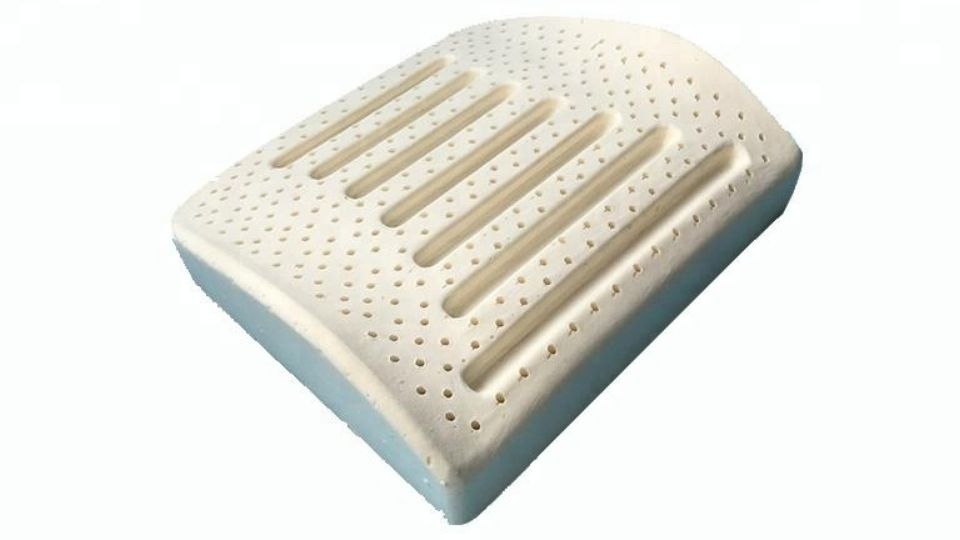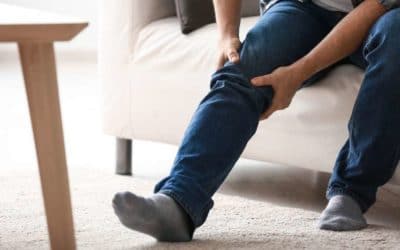When you’re walking around, your stomach is relatively flat. But as soon as you sit down, it pops out and creates a little “belly.” You may have wondered why this happens and what’s going on inside your body to make it happen. Here’s the explanation!
As a general rule, the reason your stomach is flat until you sit down depends on how the body redistributes weight and pressure in various positions. Standing and sitting together compresses all your abdominal fat into one place, making it appear more prominent and more noticeable.
If you’re sitting there right now, reading this, and suffering from abdominal bloating, I believe I can help. For over 30 years, I’ve been practicing chiropractic, and during that time, I’ve also trained as an ergonomist. I have a published book on the subject of sitting, spoke on this subject on national tv, and I have engineered several solutions to help people achieve better posture and comfort while sitting. In addition, I ran a successful Kickstarter campaign to fund the development of my latest project, a set of ergonomic seat cushions. With all this experience and expertise, I’m confident I can help you overcome abdominal bloating and find relief. So please, don’t suffer any longer – head to my YouTube channel and check out my videos. You’ll be glad you did!
Why Does My Stomach Look Fat When I Sit Down?
Stomach concerns are a common problem among many people. Whether you’re experiencing bloating, constipation, or stomach pains, it can be frustrating and challenging to figure out the root cause. One common source of stomach woes is poor posture while sitting. Sitting in an incorrect position can make your core muscles weak and lax. This can not only lead to back pain and other issues, but it can also negatively affect how your stomach appears when you sit down. To remedy this problem and improve your overall posture, it’s essential to engage your core muscles all day long with the help of things like ergonomic chair cushions and lumbar support. With these tools at your disposal, you’ll be able to keep your belly looking trim, even when sitting down!
When it comes to sitting in alignment, many critical factors must be considered. The first and most essential thing is ensuring that your chair is adjusted correctly to fit your body and support your back. This can be achieved by using an ergonomic seat cushion or lumbar support which can help relieve pressure on your back and legs. Proper positioning is essential for maintaining good posture throughout the day, whether you’re trying to prevent lower back pain or simply want more comfort as you work.
If you are into super easy and inexpensive alternatives to office chairs, I wrote a fantastic article on how and why you should consider these options for back pain, and I encourage you to read it!
Best Seat Cushion for PostureDoctor's Recommendation
Black Friday Offer!
Get 35% off Orthopedic Seat Cushion
Product DetailsResearch-based Design
Recommended ForBack Discomfort
Video Guide
Video Guide
Ergonomic Seat Cushion

- Sitting for prolonged periods can be hard on the body, and it’s easy to slouch, which can lead to poor posture and even pain in other areas of the body. To combat the effects of sitting for long periods, one solution is to maintain good posture and engage your core muscles. This can help improve balance and strength and prevent slouching, which can lead to poor posture over time.
All Day Comfort & Support
I explain the concept of an orthopedic seat cushion on a TV show HERE!
- Additionally, by keeping your body in a more upright position, the seat wedge can help to relieve tension in other areas of the body, such as the shoulders and neck. You can also reduce strain on your hips and knees by achieving better posture overall. So if you’re looking for a way to improve your posture and overall health, a seat wedge may be a great place to start.
I was surprised how similar cheap memory foam seat cushions were on Aliexpress from the listing on Amazon!
Ergonomic Lumbar Support Cushion
Having a flat stomach but losing it while sitting can be frustrating. To strengthen your core while sitting, it is important to maintain good posture and support your lower back. This can be achieved by engaging your core muscles and making sure your body is properly aligned. It is also important to move around and not stay in one position for a long time to avoid causing additional strain on your back. Following these tips can help you sit comfortably and confidently, knowing that your posture and alignment are being taken care of.
I’ve written a complete hands-on review about the best sitting position for sciatica, and here is what I tested best with my sciatica patients.
Why Do I Look Fat While Sitting?
When you sit, your spine can round and your stomach can protrude, which can give the appearance of being heavier. However, it’s not only the position of your body that can make you look bigger but also the fact that when sitting, your joints and ligaments take on more of the load, which can make you appear softer and less toned. Additionally, sitting can compress your internal organs, making them less visible. These factors can create the illusion of carrying more weight than you actually do. It’s important to remember that the way you look while sitting is just an optical illusion and should not be used to judge yourself.
Black Friday: 35% Off Today
Typical Delivery 1-3 Days
How Can I Reduce My Stomach Fat?
Reducing stomach fat can be a difficult task, but it is possible with a combination of healthy habits. To achieve this, it is important to increase your physical activity level. This can include different types of exercises such as going for walks, running, weightlifting, yoga, or Pilates. These activities can help tone and strengthen the abdominal muscles, which can help reduce the appearance of belly fat.
In addition to exercising, it is also important to make healthy food choices. This includes limiting sugary treats and processed foods and consuming plenty of fresh fruits and vegetables and lean proteins such as fish, and chicken breast. With discipline and determination, it is possible to reduce stomach fat and achieve a healthier and slimmer body.
Why Is Only My Stomach Fat?
There are some reasons why stomach fat is challenging to lose. First, the stomach is a relatively small area, so there is less surface area to burn calories. Second, the stomach is home to several vital organs, so it’s more challenging to target with exercise. Third, fat cells in the stomach are particularly resistant to weight loss. Finally, many people carry stress in their gut, leading to weight gain and additional belly fat. Despite all these challenges, it is possible to lose stomach fat with the proper diet and exercise plan. Following a few simple tips can shrink your waistline and improve your overall health.
What Are the 5 Foods That Burn Belly Fat?
A few foods have been shown to help burn belly fat. These include:
- Oats: Oats are high in fiber and protein, which help reduce appetite and promote fullness. They also contain a type of soluble fiber called beta-glucan, which has been shown to target belly fat.
- Eggs: Eggs are another great source of protein and fullness-promoting nutrients like choline. They also contain several fat-burning compounds, including leucine and green tea catechins.
- Fish: Fish is an excellent source of lean protein and omega-3 fatty acids, critical for weight loss. Studies have shown that omega-3s can help increase the calories you burn each day.
- Coffee: Coffee contains antioxidants and other compounds that can boost metabolism and promote fullness. Moreover, the caffeine in coffee has been shown to target belly fat.
- Hot peppers: Hot peppers contain a compound called capsaicin, which has been shown to boost metabolism and reduce appetite. In addition, capsaicin has been shown to target
Why Is My Stomach Getting Bigger but Not Gaining Weight?
There are many possible reasons your stomach might grow more prominent, even though you aren’t experiencing any weight gain. For one thing, your stomach may be simply bloating due to water retention. This can often happen when you eat a lot of salty foods or drink too much alcohol, and hormonal imbalances or certain medical conditions can also cause it. Changes in your gut bacteria or digestive function may also contribute to an increase in belly size without an accompanying change in weight. Whatever the cause, it’s essential to talk to your doctor if you’re noticing a significant change in your abdominal region, as it could signal a serious health issue. Whether the underlying cause is hormonal or dietary, there are steps that you can take to address the issue and get your stomach back to its standard size.
Which Fruit Will Reduce Belly Fat?
There are many different kinds of fruit, each with its unique nutritional benefits. While all fruit is good for you, some types are especially effective at reducing belly fat. One of the best is grapefruit. This citrus fruit contains a compound called naringin, which has been shown to boost metabolism and burn fat. Studies have also found that grapefruit can help to reduce insulin resistance, making it easier to lose weight. Other great options include apples, pears, and berries. These fruits are high in fiber, which helps to keep you feeling full and satisfied after eating. They also tend to be lower in sugar than other fruits, making them a healthier choice for weight loss. So if you’re looking to reduce belly fat, reach for grapefruit, apples, pears, or berries next time you’re in the grocery store.
Why Is My Stomach Bigger on the Top?
Many factors can contribute to a large, protruding stomach. The most common causes include dietary habits, lack of exercise, and medical conditions like GERD and IBS. For example, if you eat high-fat or sugary foods regularly, your body may store this excess fat around the midsection. Additionally, a sedentary lifestyle can contribute to weight gain in the abdomen due to a lack of muscle tone and decreased circulation in the abdominal region. Finally, certain medical conditions such as GERD and IBS can cause imbalances in your digestive tract that lead to bloating and an enlarged stomach. It is vital to seek professional guidance if you are concerned about your expanding midsection, as many potential underlying causes need to be addressed.
Conclusion
The takeaway? Your stomach is flat because the surrounding muscles are strong and can hold everything in. When you sit down, those muscles relax and let your stomach protrude. So, the next time you’re feeling bloated or self-conscious about your stomach, just remember that it’s perfectly normal – and pretty impressive if you think about it! – for your stomach to look a little different when standing up than when sitting down.






